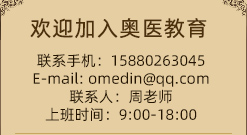| |
|
|
|
 |
在线QQ:
 |
|
|
|
|
|
|
|
|
|
《ISPN学习》总第544期
日期:2019-11-23 18:25:32
《ISPN学习》2019年10月11日总第544期
相识是缘,相知是福;
风雨兼程,不忘初心;
有您相伴,奥医感恩。
From the Programs
(From the Programs [课程选粹]栏目登载奥医及网络课程材料精选,旨在帮助读者了解ISPN/NCLEX-RN考试复习课程内容,并加深对考试相关内容的学习、掌握[课程详情见网站或点击阅读原文]。您的需要就是我们的努力方向。谢谢)
| 想提高专业英语听力吗?想边练听力边增加护理专业知识吗?《Listening -- Elementary》(专业英语听力 – 初级)可助你一臂之力。 |
ISPN Review
Antimalarials 抗疟药
1. Description 说明
Antimalarials are agents used to attack Plasmodium at various stages of its life cycle. Through this, it becomes possible to prevent acute malarial reaction in individuals who have been infected by the parasite.
These agents can be schizonticidal (acting against the red-blood-cell phase of the life cycle), gametocytocidal (acting against the gametocytes), sporontocidal (acting against the parasites that are developing in the mosquito), or work against tissue schizonts as prophylactic or antirelapse agent.
Quinine (Qualaquine) was the first drug found to be effective in the treatment of malaria.
抗疟药用于对付不同生命阶段的疟原虫。有了这些药物,也有就可能预防受寄生虫感染个体的急性疟疾反应。这些药物分为裂殖体杀灭剂(针对属于红血细胞期的疟原虫)、配子母细胞灭杀剂(针对配子母细胞)、孢子体灭杀剂(针对已经在蚊子发育的寄生虫),以及针对组织裂殖体的药物,如预防性或抗复发药物。
2. Therapeutic Action 治疗作用
The desired and beneficial action of antimalarials is:
Entering human red blood cells and changing the metabolic pathways necessary for the reproduction. Chloroquine, the mainstay of treatment, in addition to this main mechanism, is directly toxic to parasites and decreases the ability of the parasite to synthesize DNA.
抗疟药的预期和有益作用:
进入人红血细胞,改变繁殖必需的代谢途径。氯喹属于骨干药物,除了其主要机制之外,它还可以直接灭杀寄生虫,降低寄生虫的DNA合成能力。
3. Indications 适应症
Antimalarials are indicated for the following medical conditions:
Treatment of malaria, prevention of relapse, and other protozoal diseases like extraintestinal amoebiasis (chloroquine) and toxoplasmosis (pyrimethamine).
Here are some important aspects to remember for indication of antiprotozoals in different age groups:
抗疟药适用于下列情况:
治疗疟疾,预防复发,以及用于其他原虫病如肠外阿米巴病(氯喹)和弓形虫病(乙胺嘧啶)。
收下为不同年龄段应用抗疟原虫药时需要记忆的几个重要方面:
a. Children 儿童
This age group is very sensitive to the effects of most antiprotozoals and therefore more severe reactions can be expected. In addition, many antivirals do not have proven safety and efficacy in children.
该年龄段对多数抗原虫药效应极为敏感,因此,可能出现较为严重的反应。此外,很多抗病毒药的用于儿童时,药物的安全性和效应并未得到证实。
b. Adults 成人
This age group should be well advised about the need for prophylaxis against various protozoal infections and the need for immediate treatment if disease is contracted.
Administration of drug in pregnant and nursing women is only justified if benefits clearly outweigh the risk.
Women of childbearing age are advised to use barrier contraceptives when any antiprotozoal drug is being taken.
该年龄段应充分进行各种原虫感染预防必要性及一旦得病立即进行治疗必要性教育。
孕妇和哺乳妇女只有在好处明显大于风险情况下才可以用药。
育龄期妇女使用抗原虫药时,应建议其使用屏障避孕器。
c. Older adults 老年人
Older patients are more susceptible to adverse effects of antiprotozoal therapy, particularly those with hepatic and renal dysfunctions.
老年病人更易受抗疟疗法不良效应的影响,特别是肝、肾功能障碍的病人。
4. Contraindications and Cautions
禁忌症和注意事项
The following are contraindications and cautions for the use of antimalarials:
Known allergy to the drug. Prevent hypersensitivity reactions.
Liver disease or alcoholism. Parasitic invasion of the liver and need for hepatic metabolism to prevent toxicity.
Lactation. Drugs can enter breast milk and could be toxic to infant.
Pregnancy. Associated with birth defects. Pregnancy should be avoided two months after completion of therapy using mefloquine.
Retinal disease or damage. Drugs can affect vision and retina, and the likelihood of problems increase if the retina is already damaged.
Psoriasis or porphyria. Skin damage as a result of drugs on proteins and protein synthesis.
抗疟药禁忌及注意事项如下:
已知药物过敏,预防超敏反应。
肝病或酒精中毒。寄生虫侵袭肝脏,需要肝代谢以预防中毒。
哺乳。药物可能进入母乳,可能对婴儿产生毒性。
妊娠。与出生缺陷相关。使用甲氟喹者,疗法完成后两个月内应避免怀孕。
视网膜病或损坏。药物可影响视觉和视网膜。若视网膜已经损坏,该问题可能性增加。
银屑病和卟啉病。药物影响蛋白质和蛋白合成,导致皮肤破坏。
5. Adverse Effects 不良效应
Use of antimalarials may result in these adverse effects:
CNS: headache, dizziness
Immunological: fever, shaking, chills, malaise
GI: nausea, vomiting, dyspepsia, anorexia, hepatic dysfunction
Dermatological: rash, pruritus, loss of hair associated with changes in protein synthesis
Eyes: visual changes, possible blindness
Ears: ototoxicity related to nerve damage. Cinchonism (nausea, vomiting, tinnitus, and vertigo) may occur with high levels of quinine or primaquine.
使用抗疟药可能导致下列不良效应:
CNS – 头痛、头晕
免疫反应 -- 发烧、发抖、发寒、全身乏力
GI – 恶心、呕吐、消化不良、厌食、肝功能障碍
皮肤病学 -- 皮疹、瘙痒、与蛋白合成相关的脱发
眼 – 视力变化,可能致盲
耳 – 耳毒性,与神经破坏相关。奎宁或伯氨喹浓度较高时可能出现金鸡纳反应(恶心、呕吐、耳鸣、眩晕)
6. Interactions 相互作用
The following are drug-drug interactions involved in the use of antimalarials:
Quinine and quinine derivatives: increased risk for cardiac toxicity and convulsions
Anti-folate drugs (methotrexate, sulfonamides): increased bone marrow suppression with pyrimethamine. Discontinue pyrimethamine if signs of folate deficiency develop (diarrhea, fatigue, weight loss, anemia).
抗疟药使用时的药药相互作用如下:
奎宁和奎宁衍生物:增加心脏毒性和抽搐风险
抗叶酸剂(甲氨蝶呤、磺胺类药):乙胺嘧啶增加骨髓抑制。出现叶酸缺乏症状(腹泻、疲劳、体重减轻、贫血)时,停用乙胺嘧啶。
Vocabulary for Today
schizonticidal – a. n. 裂殖期灭杀的(药)
gametocytocidal – n. a. 配子母细胞灭杀的(药)
sporontocidal – a. n. 孢子体灭杀的(药)
schizonts – n. 裂殖体
antirelapse – a. 抗复发的
toxoplasmosis – n. 弓形虫病
psoriasis – n. 瘙痒
porphyria – n. 卟啉病
Cinchonism – n. 金鸡纳反应
| 尽快地从茫然中理清复习思路,准确地抓住复习重点,这是每一个考试复习者的一大愿望。“ISPN考试复习要点提示”即是帮您实现这一愿望的利器!该教程已在www.omedin.com陆续上线。 |
Video
Antimalarials
Test
1. Silver sulfadiazine is prescribed for a client with a burn injury. Which laboratory finding requires the need for follow-up by the nurse?
A. Glucose level of 99 mg/dL (5.65 mmol/L)
B. Magnesium level of 1.5 mEq/L (0.75 mmol/L)
C. Platelet level of 300,000 mm3 (300 × 109/L)
D. White blood cell count of 3000 mm3 (3.0 × 109/L)
2. A burn client is receiving treatments of topical mafenide acetate to the site of injury. The nurse monitors the client, knowing that which finding indicates that a systemic effect has occurred?
A. Hyperventilation
B. Elevated blood pressure
C. Local rash at the burn site
D. Local pain at the burn site
(本期答案见页底)
本期ISPN Review答案:
1. D
Silver sulfadiazine is used for the treatment of burn injuries. Adverse effects of this medication include rash and itching, blue-green or gray skin discoloration, leukopenia, and interstitial nephritis. The nurse should monitor a complete blood count, particularly the white blood cells, frequently for the client taking this medication. If leukopenia develops, the health care provider is notified and the medication is usually discontinued. The white blood cell count noted in option 4 is indicative of leukopenia. The other laboratory values are not specific to this medication, and are also within normal limits.
2. A
Mafenide acetate is a carbonic anhydrase inhibitor and can suppress renal excretion of acid, thereby causing acidosis. Clients receiving this treatment should be monitored for signs of an acid-base imbalance (hyperventilation). If this occurs, the medication will probably be discontinued for 1 to 2 days. Options 3 and 4 describe local rather than systemic effects. An elevated blood pressure may be expected from the pain that occurs with a burn injury.
上一篇:《ISPN学习》总第543期
下一篇:《ISPN学习》总第545期
|
|
 |
| |
|
|
